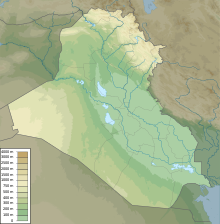Battle of Nineveh (612 BC)
| Battle of Nineveh | |||||||
|---|---|---|---|---|---|---|---|
| Part of Medo-Babylonian conquest of the Assyrian Empire | |||||||
 The Fall of Nineveh, by John Martin | |||||||
| |||||||
| Belligerents | |||||||
| Neo-Assyrian Empire |
Neo-Babylonian Empire | ||||||
| Commanders and leaders | |||||||
| Sinsharishkun † |
Cyaxares Nabopolassar | ||||||
| Casualties and losses | |||||||
| Unknown | Unknown | ||||||
Location within Iraq | |||||||
The Battle of Nineveh is conventionally dated between 613 and 611 BC, with 612 BC being the most supported date. Rebelling against the
Babylon became the imperial center of
Background
The Neo-Assyrian Empire emerged in the 10th century BC and peaked in the 8th and 7th centuries BC, succeeding the Middle Assyrian Empire (1366–1074 BC) as the largest empire the world had yet seen. By the reign of
in the west.However, after the death of King
The Assyrians had, by the accounts of their own records, been brutal rulers even by the standards of the time, and thus had accumulated many hitherto impotent enemies. It had been weakened by a three-front struggle to maintain power in Egypt, wage a costly but victorious war against the
Upon the death of Ashurbanipal, a series of bitter and bloody wars of succession occurred, weakening the empire – from 625 BC onward, the empire's domination over the
An alliance formed between external states, such as the Chaldeans, who took advantage of the upheavals in Assyria to take control of much of
The Assyrian chronicles end abruptly in 639 BC after the destruction of
The Medes were ruled by King Cyaxares. Although initially defeated by the Assyrians, he rebuilt his army and attacked Nineveh in conjunction with other warring factions.
Account of the battle
One of the recountings of the actual battle is taken from the excerpts of
According to a Babylonian clay tablet discovered in the 19th century named the Fall of Nineveh Chronicle, there was a bitter 12-year struggle between Babylon and Assyria, as well as civil wars in Assyria itself. They describe that in the tenth year of Nabopolassar (616 BC) the Babylonians defeated the Assyrian army and marched up the river, sacking Mane, Sahiri and Baliḫu.
The conflict was renewed the next year, with the Assyrians mustering their army and driving the Babylonians back to Takritain. Nabopolassar stationed his army in the fortress of Takritain, and the two armies fought there the next year. The Assyrians were beaten and retreated to Assyria.
The Babylonians then allied with the Medes and Scythians. The Median army took Tarbisu, near Nineveh, and encamped nearby; they then attacked the city of Assur, with the Babylonian text recounting how in 614 BC their Median ally destroyed Assur's temples and sacked the city, but their army did not reach the city until after the plundering had been done.[5]
In 612 BC, the Babylonians mustered their army again and joined with Median king
According to tradition laid out in Diodorus, the Tigris river flooded the city. While his account is often suspect, this aspect has been given attention. The allied armies entered the area of the outer wall and fought to enter the palace. Temples were looted and the palace was burned, though this did not destroy the city, and may have aided the preservation of clay texts.
Aftermath
There would be several more campaigns against Assyria by the Neo-Babylonians and their allies, including one against an allied Egyptian-Assyrian army. Thus, while the battle of Nineveh was a turning point in the war, Ashur-uballit II would fight on for several more years. His ultimate fate is not known or recorded — he may have been killed at the fall of Harran in 609 BC (which ended the Assyrian Empire) or at Carchemish in 605 BC (where Egypt and remnants of the army of the former Assyrian Empire were defeated); or he may have simply disappeared into obscurity.
See also
References
- ^ A Companion to Assyria "The decisive blow came in 612, when Babylonian and Median armies , after a two-month long siege, conquered Nineveh"
- ^ Georges Roux - Ancient Iraq p 376
- S2CID 193037843.
- JSTOR 23064050.
- ^ The Fall and Rise of Jerusalem: Judah Under Babylonian Rule : page 18
- ^ Encyclopedia Iranica "Finally, after three months of siege, in August of 612, the joined forces of the Medes and Babylonians stormed Nineveh, the Assyrian capital, and took it. The major part in the city’s downfall was played by the Medes."

